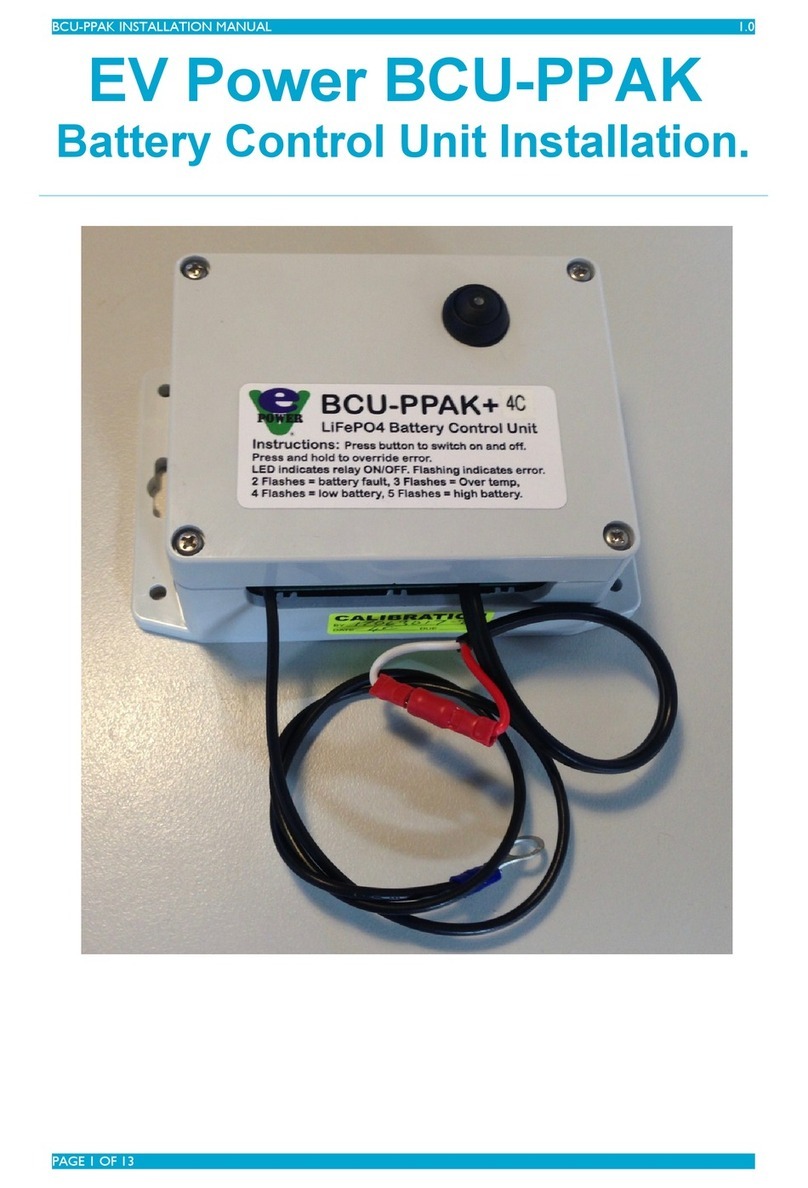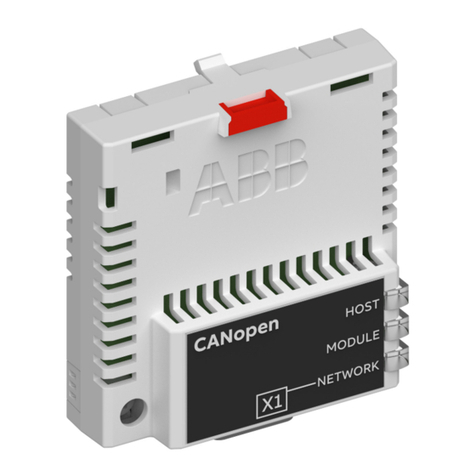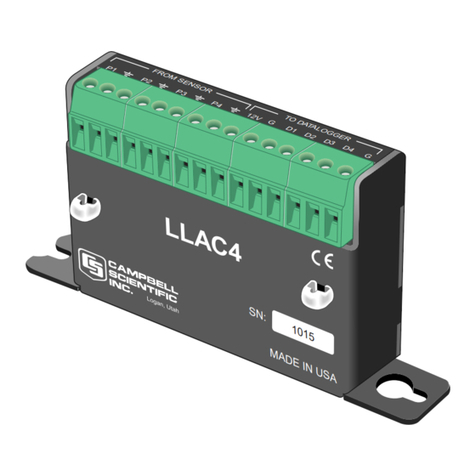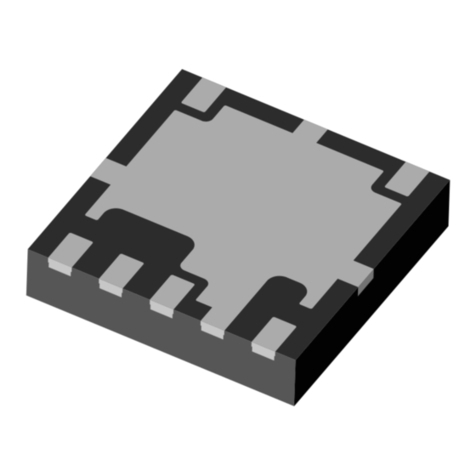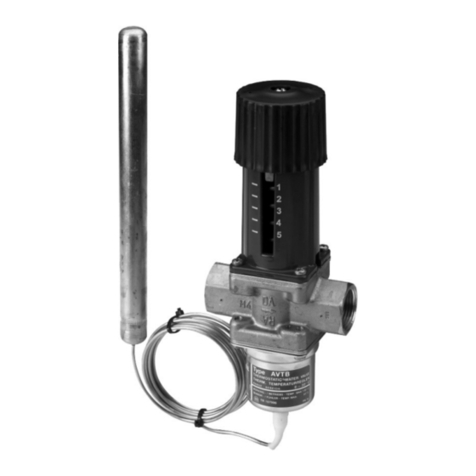EV-POWER BCU-NEV-XXC User manual

BCU-NEV-XXC MANUAL 1.0
EV Power - Battery Control Unit
NEV-5.x Installation
Instructions.
PAGE OF1 17

BCU-NEV-XXC MANUAL 1.0
BCU-NEV Features
- Simple to install and use, microprocessor control.
- 2 Line OLED monitor display, Volts, Amps, Ah, %SOC
- Inbuilt 240A latching relay for load and charger control
- Low power requirement.
- Prevents overcharge and over-discharge of LFP batteries.
- 12-60VDC nominal (4-16 cell) models available. !
4Cell, 8C, 12C and 16C Models are preconfigured at the factory
- 100A cont. 200A peak capacity with latching relay.
- Plug (bolt) and play with EV Power Pak 12V batteries.
- Designed for use with EV Power A series Chargers.
- Measures current on the positive rail so no requirement for an external shunt.
!
BCU-NEV Specifications
- Supply Voltage - NEV-04C to NEV-08C, 9-36VDC!
NEV-08C to NEV-16C 36-48VDC
- Power Consumption - 3mA (off), 5mA (on) @ 48VDC
- Switching current - 100A continuous (12/48V)
- Dimensions - 90 x 117 x 55mm
- Weight - 700g
- Environmental - 0 to +50°C
Objective of this manual
This manual will help with installation and operation of the BCU-NEV battery control unit in
conjunction with EV Power Power Paks.!
!
An understanding of electrical principles and competence with electrical tools is required. Ability
to use the volts, amps and Ohms setting of a multimeter is a prerequisite."
PAGE OF2 17

BCU-NEV-XXC MANUAL 1.0
Disclaimer
This is a guide only. Potentially lethal voltages and currents are involved when working with
batteries. It is the responsibility of the installer to have the appropriate qualifications and
skills for working with high voltages. No liability whatsoever will be assumed by EV Power for
injury, accidents or damage resulting from the use of these instructions.
Read these instructions several times before commencing installation.
!Do not try to charge or discharge Lithium (LFP) batteries
without the BCU installed. One over-charge or over-discharge
WILL cause permanent damage.!
Every effort has been made to make this apparatus as reliable and robust as possible. However
electronics can fail. The BCU-NEV is designed to be the last line of battery protection and should
not be relied upon to disconnect the battery under normal operating conditions. Connected loads
and chargers should have inbuilt low/high voltage cutoffmechanisms. EV Power assumes no
responsibility for battery damage resulting from failure of the BCU.
Introduction
The EV Power Battery Control Unit is designed for Lithium Iron Phosphate (LiFePO4, LFP)
batteries of capacity 40-900Ah and nominal voltage of up to 60VDC. These batteries are generally
used in applications where light weight, high power and long life are required.
The BCU-NEV is designed to control LFP battery packs. It monitors overall battery voltage and
also the condition of each cell via the patented one wire link to BMS cell modules.
It is designed to be the simplest possible method of providing complete LFP battery protection. !
This overall system consists of a single Battery Control Unit (BCU) and multiple cell modules that
bolt directly on top of each cell. The cell modules perform the cell balancing function during
charging and connect together via a one wire interface. The BCU controls a relay that interrupts
power to/from the load and/or charger in the event of a battery problem.!
Battery fuel gauge functions are incorporated in the system. The EV Power Gauge is the display
method.
In combination with an approved switch mode charger the BCU-NEV-xxC will provide automated
charging of EV Power Paks or LFP cells with EV Power BMS modules attached.
PAGE OF3 17

BCU-NEV-XXC MANUAL 1.0
How it works - BCU Usage
Cell Modules Input connects to the cell module loop of the battery. If no cell modules are used this
input can be shorted together to simulate OK signal.!
!
Note the current measuring shunt is internal to the unit and connected in the positive line.
The ON/OFF (remote enable momentary push button) switch is mounted on the gauge display. It
causes the latching relay to enable/disable.
Latching Relay Output connects to an optional external 3 wire latching relay which can switch extra
load and charging currents.
Discharge Enable Output can optionally be used to control the enable input of a motor controller.
Voltage free contact 50mA maximum.
PAGE OF4 17

BCU-NEV-XXC MANUAL 1.0
Charge Enable Output can optionally be used to control a charger such as the EV Power A-series
range. It will keep the charger enabled even if the voltage drops low so that the battery can still be
charged. If there is a cell module error charging will be inhibited. 50mA maximum.
Note the relay is a magnetic latching type so it uses no power when enabled but will
NOT automatically switch off if power to it is removed. It relies on the "brain" of the BCU to
control it, so the BCU must be powered at all times.
The warning light will flash for 30 seconds if the battery drops below the minimum voltage
threshold.
It will switch offpermanently and the relay will disengage if either the 30 second delay has elapsed
or the cell modules signal a cell fault.
The BCU performs a number of functions:
1) It monitors the battery voltage, if the voltage falls below the minimum or rises above the
maximum (flashing red LED) for more than 60 seconds the relay will open. Then will be a solid
red LED.
2) It monitors the BMS cell module loop. If any cell goes below 2.6V or above 4.0V (flashing red
LED) for more than 10 seconds the relay will open. Solid red LED.
PAGE OF5 17

BCU-NEV-XXC MANUAL 1.0
3) If the battery voltage is below the minimum or above the maximum and the BMS cell loop
signals an error on one cell the relay will immediately open, no delay. Solid red LED.
If the relay is open and there is a solid red LED the system may be reset by switching the remote
enable line off and then on again. This will engage the relay for a short period to allow recharge.
The relay is a special type. It consumes no power when switched on. The downside of this is that it
can remain on if power to the BCU is removed or if the BCU fails for any reason. Check that the
relay is operating correctly occasionally by switching off and on the BCU.
!SOME LOADS AND CHARGERS HAVE INTERNAL CAPACITORS
WHICH DRAW LARGE INRUSH CURRENTS WHEN CONNECTED. THIS MAY
CAUSE THE RELAY CONTACTS TO FUSE CLOSED. SUITABLE PRE-
CHARGE CIRCUITS SHOULD BE INCORPORATED.
!DO NOT DISCONNECT POWER TO THE BCU WHILE THE RELAY IS
IN THE ON STATE or battery protection will be removed.!
!
!Reverse polarising the battery will cause damage to the BCU-NEV and void
warranty.!
!
If the BCU cuts off the battery during discharge the battery is most likely nearly empty. DO NOT
RESET AND CONTINUE DISCHARGE! Reset and charge the battery immediately.
Note that the low voltage cutoff threshold equates to approximately 10% remaining battery
capacity, more or less. The battery should be considered to be flat at this level to allow for a safety
buffer.
Note that even when switched off the BCU consumes a small parasitic current. It will take some
months to drain a full battery at this rate but it is best to either leave the battery on continuous float
charge or to disconnect the BCU if the battery is to be stored for long periods.
If the relay opens during charging it means either the charge voltage has gone to high or the cells
are unbalanced. Try reseting and charging a few times. If one red LED on the BMS cell modules on
the battery comes on long before the others then that cell is running too high. Contact EV Power for
advice in this instance.
In normal day to day use with charging and discharging one would leave the BMS and main battery
isolator switched on. It is not really possible to use a key switch with the button as such to switch
the BCU on/off.
There are two trimpots on the PCB. They are for adjusting the battery and load voltages and are set
in the factory. Only the LOAD trimmer is field adjustable to trim the displayed voltage (as
displayed on the monitor) to match the actual voltage. Please do not touch the battery voltage
trimmer.
PAGE OF6 17

BCU-NEV-XXC MANUAL 1.0
!The BCU is the last line of defence for the battery pack. It should not be
relied upon to disconnect the battery every time it is used. It is there as a backup. No
battery warranty can be assumed if the load has no inherent low voltage cutoff.
Note that the current shunt is internal and on the positive line. ALL NEGATIVES
ARE COMMON.!
PAGE OF7 17

BCU-NEV-XXC MANUAL 1.0
"
PAGE OF8 17

BCU-NEV-XXC MANUAL 1.0
Monitor - Standard Equipment
The Monitor 162 is a 16 character, 2 line OLED display.
It displays Volts (on the load terminal), battery amps, estimated battery amphours remaining and
estimated battery State of Charge percent.
It can also be used to configure some parameters in the BCU such as number of cells and Ah
capacity.
PAGE OF9 17

BCU-NEV-XXC MANUAL 1.0
Fuel Gauge - Optional Equipment
The BCU-NEV comes with a 10 segment LED fuel gauge as standard. The 10 segments represent
approximately 10% intervals of SOC measured via amphour counting.!
!
!
!
With regards to the fuel gauge, the BCU is preset in the workshop for a xxC-yyAh (xx = 4-16 cell ,
yy = 40-980Ah) pack so should be reasonably accurate initially.
The BCU will reset the Gauge to 100% when the battery voltage rises above 3.50V x number of cells
#for 30 seconds.#The BCU will then count the Ah drawn down from there and calculate the SOC as
a percentage of the total actual battery capacity.
If the overall battery voltage falls below 2.9V x number of cells #the battery is considered to be flat,
the warning light will flash and the alarm will beep for 30 seconds. After this period the alarm will
become continuous and the battery will be switched off.
To restart, switch offthe BCU and then on again whilst charging. This will kick the voltage up
above the lower threshold and allow the battery to charge.
Similarly if one or more of the cells goes outside its safe voltage range (2.6V - 3.9V) the BCU will
sound the alarm and switch offthe battery after 30 seconds. This should only happen if there is a
battery problem such as an out of balance cell.
The battery capacity and SOC is remembered by the BCU even when it is switched offand
disconnected from the battery.
Please note that if the machine is being stored for more than a week at a time the BMS should be
switched off via the button on the Gauge.
PAGE OF10 17

BCU-NEV-XXC MANUAL 1.0
If storing for more than a month the BMS should be off and also the main battery isolator (which
supplies power to the BCU also) should be off.
If the battery is over-discharged and the charger will not enable then a temporary override
is to press and hold the on-offbutton. Do this only once for maximum 60 seconds to see if the
battery will come up to minimum voltage. If it does not then do not persist, check the battery.
Error Messages
The BCU will flash an error signal if there is a problem.!
' 0 = STATUS- OK(0), CLOSEDOWN MODE(1)
' 2 = CELL MODULE CURRENT LOOP - OK (0), BROKEN LOOP ERROR (1)
' 4 = BATTERY UNDER-VOLTAGE FLAG - OK (0), UNDERVOLTAGE (1)
' 5 = BATTERY OVER-VOLTAGE FLAG - OK (0), OVERVOLTAGE (1)
' 6 = CURRENT LIMIT - IN RANGE (0), OVERCURRENT (1)
About Pre-charging and Voltage Trimpots
The BCU has an automatic precharge circuit that precharges any capacitors connected on the load
side of the relay.
In this way it protects the main relay from welding shut due to high inrush currents when switched
on. If the precharge lasts too long (>15 secs) the relay will switch on anyway, so this must be
accounted for with any application.
Initially a current limiting resistor is switched in the circuit an the BCU monitors the load voltage
and compares to the battery voltage.
Once the load reaches 90% of the battery voltage the main relay will be engaged.
Using the OLED monitor the LOAD voltage can be trimmed to be correct simply by measuring the
actual voltage and comparing it on the screen.
There is no easy way to trim the BAT voltage pot. It needs the factory programming cable to be in
place.
PAGE OF11 17

BCU-NEV-XXC MANUAL 1.0
General Battery Guidelines
LFP cells should be housed in a battery box away from dust, excessive heat and moisture.
Appropriate restraints should be used that are capable supporting at least 4 times the battery weight
in the event of a vehicle rollover. All restraints should be well insulated so as not to short out battery
terminals.!
!
Ensure that a dry powder type fire extinguisher is accessible somewhere close by. Lithium Iron
Phosphate batteries do not generally catch fire even under extreme abuse. However they will burn if
heat is applied from another source such as a short circuit. They contain organic solvent electrolyte
which is flammable when released.
!Be careful when working on batteries with metal tools, short circuits can
occur very easily with catastrophic consequences. The handles of metal tools should
be insulated with heat shrink or plastic duct tape.
PAGE OF12 17

BCU-NEV-XXC MANUAL 1.0
!DO NOT ALLOW YOUR BATTERY TO DISCHARGE TO ZERO VOLTS.
IT WILL BE PERMANENTLY DAMAGED AND EV-POWER CAN TAKE NO
RESPONSIBILITY FOR THIS.!
!
!THE BATTERY SHOULD BE CHARGED REGULARLY IF BEING
STORED.
Cell Module Installation
The cell module signal current loop cable must be connected via daisy chain to the BMS cell
modules. The polarity does not matter.!
!
This is covered in another manual. Install the cell modules first. It is not required for the
prefabricated EV Power Pak batteries.!
!
The cell module daisy chain should be one single series string, not two or more
strings in parallel. Disconnecting one signal wire anywhere in the loop should immediately
activate the BCU alarm.
Charger Control
We use and recommend Elcon chargers for the BCU-NEV range. The BCU “charger control” output
may be used to enable/disable the charger. In this case the Elcon output terminals may be connected
directly to the battery positive and negative terminals.
PAGE OF13 17

BCU-NEV-XXC MANUAL 1.0
Any other charger used should charge to 3.55V x the number of cells in the battery. This peak
voltage applies to all LiFePO4/LFP battery brands and is required for correct balancing to be
applied by the BMS.
Note: 3.50-3.55V/cell is the standard peak charge voltage for
LiFePO4 (LFP) chemistry.
It is important that once the peak voltage is reached the charger should begin to taper the charge
current and switch off or fall to a lower voltage when the current falls to 1% of the Ah capacity.
Most modern chargers have a “Gel” or “AGM” charge program which can be acceptable for LFP
batteries. Charge to 29.2-29.4V then float indefinitely at 27.2-27.4V. The charger may be left on
when the battery is not in use if it has this characteristic.
Do not use chargers which have an “equalization” phase (unless it can be disabled). This will try to
charge the battery too high and damage it.!
Commissioning the system
First double check all the connections.
Switch on the BCU.
After double checking all high voltage connections connect the AC power to the charger input. The
charger should commence charging. If not then check that all the green cell module LEDs are
illuminated and all the cell module and signal wires are correctly connected.!
Do this for a few seconds and switch off the charger at the wall.
PAGE OF14 17

BCU-NEV-XXC MANUAL 1.0
Disconnect one of the signal wires between the cell modules. The red LED on the BCU will flash
After a delay of about 10 seconds the relay will switch off. Switching on the charger at this time
should have no effect, that is, it will not switch on. Switch the charger off at the wall and reconnect
the signal wire.
Reset the BCU by switching OFF/ON again.!
Switch on the charger, it should now work. Charge until the battery is full and the charger switches
off. If the BCU switches off then an overcharge has been attempted. Reset and recharge while
watching the battery closely.
!
The battery should now be ready for use.
General Charging Tips
Once the battery pack is balanced it can be used and charged as required. Occasional partial
recharges are acceptable but should not be commonplace or the balance of the battery may be
affected.
If there is a battery error the BCU will terminate charging. This may not be serious if the battery is
slightly out of balance after a few partial charges or deep discharges. However if it persists it may
be necessary to check the battery.
If the battery has been discharged to a point where one or more of the cells is below 2.5V the BCU
will disconnect the battery. In this case reset the BCU by switching OFF/ON and recharge
immediately.
If the BCU keeps terminating charging not do not persist or worse battery damage may result.
Check the battery and charge individual cells if required using a small current (1A max).
About Lithium Iron Phosphate Batteries
A “battery” is made up of “cells”. Each cell is an individual unit that cannot be split into a lower
voltage component.
LFP cells have a nominal voltage of 3.2-3.4V. This is the voltage that the cells drop back to when at
rest. They will stay around 3.2V until about 90% discharged when the voltage will begin to
decrease until fully discharged at 2.5V. It is highly recommended to discharge less than 80% of the
cells total Amp Hour capacity. This will help to maximize the cell life.
LFP cells may be connected in “series” (+ to – to + etc) to obtain a higher nominal voltage. This
creates a “battery”. They may also be connected in “parallel” (+ to +, - to -) to increase the Ah
capacity. Under no circumstances should cells or a battery be short circuited, that is the +
connected directly to the – to create a loop. This will damage the cells and most likely the operator
also.
Under no circumstances should the cell voltage be allowed to fall below 2.5V for a sustained
period. Permanent damage will result. It is possible that this situation may occur if the battery is
allowed to stand for a long time (ie. months). In this situation the BMS will not allow recharge
because a cell is outside the safe range. To try and rectify the problem a small 4.5V 300mAh DC
plug pack type power supply can be applied to individual cells one at a time until the cell voltages
rise above 2.5V and the BMS will allow normal charging to commence. Care must be taken with
the first few charges as the battery may be severely unbalanced.
PAGE OF15 17

BCU-NEV-XXC MANUAL 1.0
A visual check of the battery pack during charging should be made every 3 months. Switch off the
BCU and on again to check that the contactor is operating correctly. Check the cells for corrosion or
other damage.
Important Notes
•Recharge fully regularly"
LFP batteries do not have a memory. However every so often it is important to charge the battery pack
completely until the charger switches off. Continual partial recharges will prevent the BMS balancing the
pack and so may result in premature charger disconnects when the battery is next fully charged.
•Never tap a portion of the battery for powering lower voltage peripheral
devices. "
This will unbalance the battery and result in continual charging errors. Use a suitable DC-DC converter
to power low voltage devices.
•Do not bypass the BCU during charging. "
It is designed to protect your battery but cannot do so if it is disconnected. The charge current must be
supplied via the BCU. If there is a problem with the BMS do not charge the battery until it is corrected.
•Do not allow the battery to go flat. If it goes flat this is a very serious situation. The
battery should be periodically charged when it is being stored to prevent self discharge. The BMS
uses a small amount of power whether the battery is used or not so regular charging is important.
Some Q and A
Am I better off to go with 3 x 70AH cells or 1 x 210 AH cell? Are 3
batteries a safer way to go than 1?
No, simpler is better.
What does the external fuel gauge tell you?
10 segments of battery fuel level (Ah counting method, not simple voltage level), power
!and warning lights.
Can these batteries be charged through an Anderson charger from the car?
Yes but a DC-DC charger is advisable because of voltage drop in the wires.
Do I need different chargers to what I listed?
It is best to purchase a dedicated LFP charger, we have a 12V 45A model.
Can these batteries be charged straight from the DC outlet on a Honda
generator?
Yes if you wish, but it will be slow.
PAGE OF16 17

BCU-NEV-XXC MANUAL 1.0
Glossary
Ah (Amphour) - Unit of relative capacity measurement for batteries. 10 amps drawn for 5 hours =
50Ah. For lithium cells the Ah capacity is usually calculated over a one hour period. Note that Wh
(Watthour) is a more accurate method for comparing batteries of different voltages.!
!
Battery - a number of cells connected in series and/or parallel.
!
BCU - Battery control Unit. A battery management box that contains electronics to protect LFP
batteries.!
!
BMS - Battery Management System. Includes the BCU and cell modules.!
!
Cell - one individual unit of a battery. Lithium (LFP) cells have a nominal voltage of 3.2-3.3V
Cell Module - a small electronic battery management device that connects between the positive and
negative terminal of a lithium cell. It regulates the cell voltage during charging and reports back to
the BCU if a cell falls outside its safe operating voltage of 2.5-4.2V.
Contactor - a big relay.!
!
DOD - Depth of Discharge. Similar to SOC except it is expressed as a percentage down from full.
eg. 100% DOD = empty.
LiFePO4 (LFP) - Lithium Iron Phosphate used in the EV Power battery chemistry.
Nominal Voltage - the resting voltage of a charged cell. For Lithium cells this is normally 3.2-3.3V.!
Series connection - electrical connection of cells daisy chained positive to negative to increase the
battery voltage. Battery voltage = cell voltage x number of cells in series.
Parallel connection - electrical connection of cells positive to positive, negative to negative. This
increases the amp hour capacity but maintains the same cell voltage. Battery capacity = cell
capacity x number of cells in parallel.!
!
Series Connection - electrical connection of cells positive to negative in a daisy chain. This
increases battery voltage the but maintains the same amp hour capacity. Battery voltage = cell
voltage x number of cells in series.!
!
Relay - a switch controlled by an electrical signal.!
!
SOC - State of Charge, normally expressed as a percentage of the total Ah capacity of the battery.
eg. 100% SOC = Full!
!
Watts (W) - a measure of electrical Power. Watts = Amps x Volts , (P = I . V)
PAGE OF17 17
Table of contents
Other EV-POWER Control Unit manuals
Popular Control Unit manuals by other brands
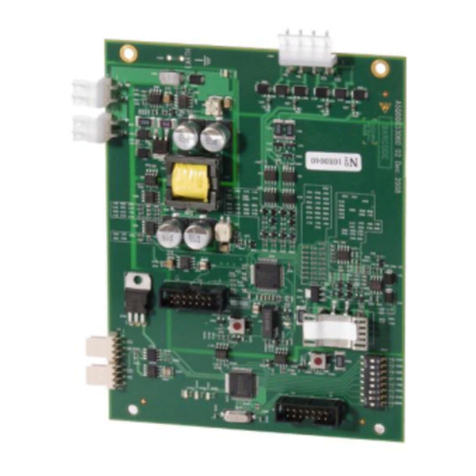
Siemens
Siemens FCI1802-A2 product manual

CD Automation
CD Automation REVEX 3Ph 120-210A user manual

Avitech
Avitech Sequoia 2H2U user manual

Wandel & Goltermann
Wandel & Goltermann OLA-35 Description and operating manual
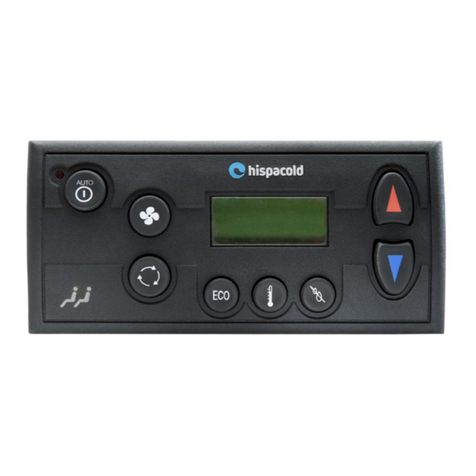
Hispacold
Hispacold Ecomaster Clima MH-012 user manual
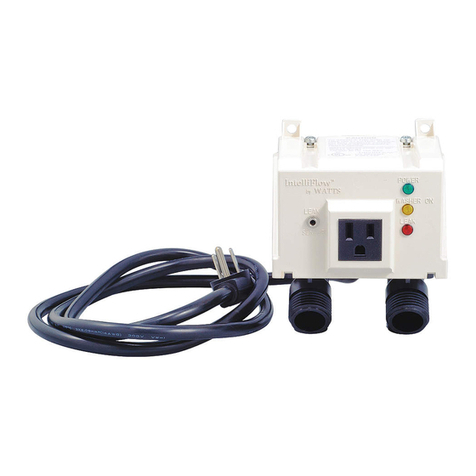
Watts
Watts IntelliFlow A2C-M1 operating instructions
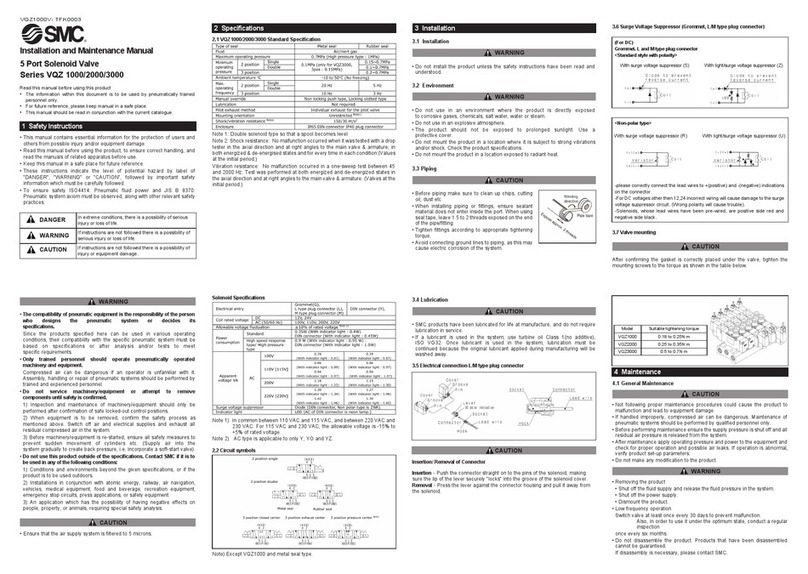
SMC Networks
SMC Networks VQZ 1000 Installation and maintenance manual
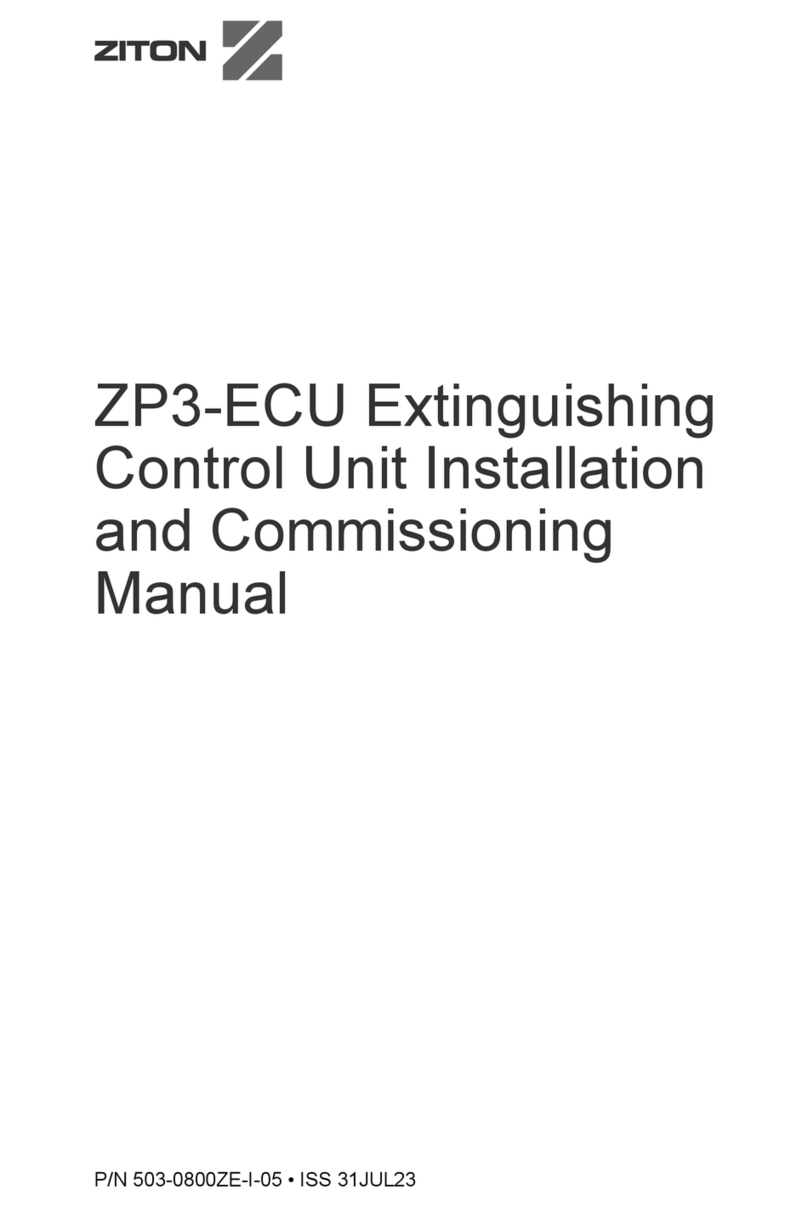
Ziton
Ziton ZP3-ECU Installation and commissioning manual

Emerson
Emerson Fisher ED instruction manual

Siemens
Siemens 3VM9.88-0LB10 operating instructions
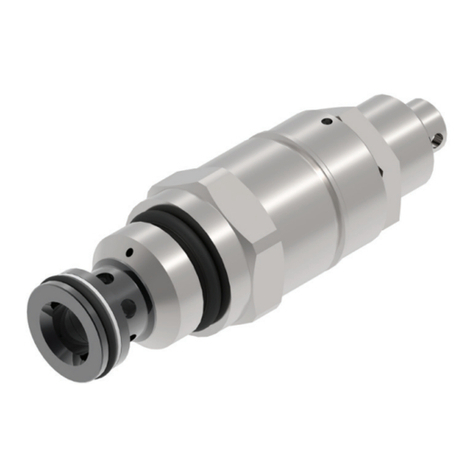
Ponar Wadowice
Ponar Wadowice UZPS6 Operation manual
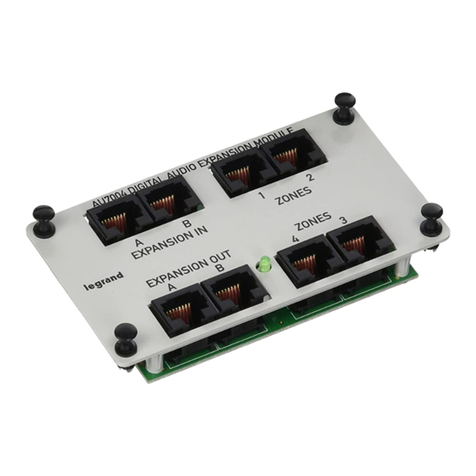
LEGRAND
LEGRAND AU7004 installation instructions
